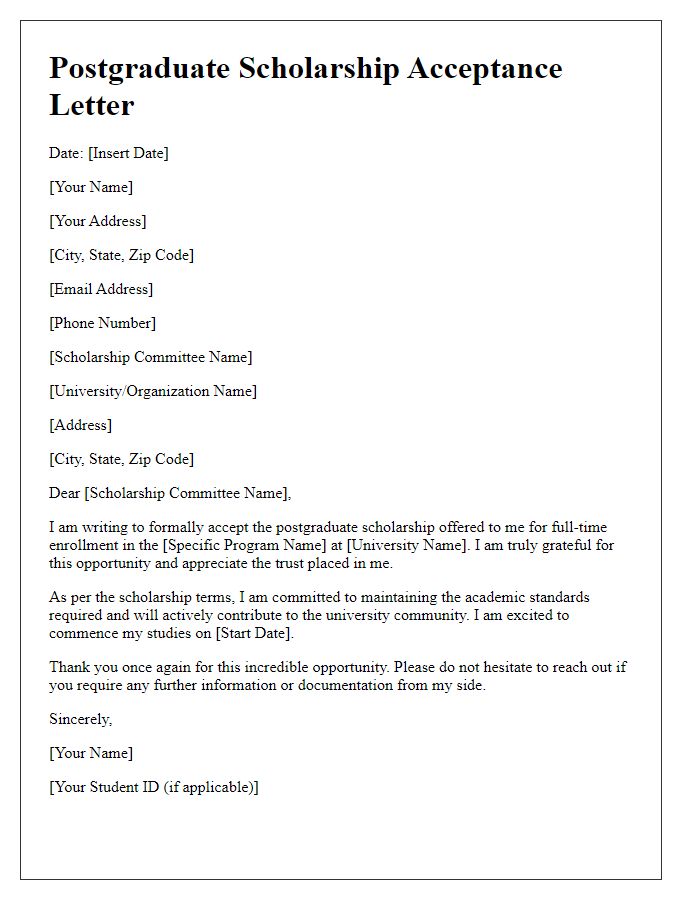Congratulations! If you're reading this, you're likely on the exciting journey of postgraduate studies and have received a scholarship acceptance letter. This achievement not only recognizes your hard work but also opens doors to incredible opportunities in your academic and professional future. In this article, we'll explore the key elements of a scholarship acceptance letter, providing you with a handy template to ensure you express your gratitude and enthusiasm properly. So, let's dive in and discover how to craft the perfect letter together!

Formal Greeting
Formal greetings can convey respect and professionalism in scholarship acceptance letters. Starting with "Dear [Scholarship Committee or Name]" creates an immediate connection. For example, "Dear Scholarship Committee," or "Dear Dr. Smith," establishes a clear tone of formality. Including titles and last names, when applicable, enhances respect. If addressing multiple individuals or committees, "To Whom It May Concern" is an appropriate alternative, though more general. Personalization could also involve mentioning the specific scholarship name, reinforcing the context of the correspondence, such as "Dear [Scholarship Name] Committee."
Expression of Gratitude
Receiving a postgraduate scholarship can significantly impact a student's academic journey and career goals. This type of financial assistance, often provided by universities or organizations, reduces the burden of tuition fees and living expenses. Students often express heartfelt gratitude for such support, recognizing the effort of scholarship committees, donors, or institutions in making this opportunity possible. Acknowledging the scholarship not only highlights the student's appreciation but also reinforces the importance of community and financial support in the pursuit of higher education. This gratitude can foster lasting relationships between scholars and their benefactors, ultimately enriching the academic environment.
Confirmation of Acceptance
The confirmation of acceptance for a postgraduate scholarship represents a significant milestone in an academic journey. This document typically includes essential details such as the scholarship name (e.g., Fulbright Scholarship), funding amount (often reaching thousands of dollars), and the institution's name (Harvard University) where the recipient will study. Additionally, acceptance usually stipulates the duration of the scholarship (often one to three years), academic program (Master's in Public Health), and specific responsibilities (such as maintaining a minimum GPA of 3.5). It may also outline financial support for research projects, travel allowances, and other resources provided by the scholarship committee. This formal acceptance not only acknowledges the recipient's academic achievements but also paves the way for future contributions to their field of study.
Scholarship Terms and Conditions
Postgraduate scholarships often come with specific terms and conditions that students must adhere to in order to maintain their funding. When a scholarship applicant accepts a postgraduate scholarship, they typically agree to fulfill requirements such as maintaining a minimum GPA (Grade Point Average, often set at 3.0 or higher), completing a designated number of credit hours, or participating in certain academic or community service activities. Scholarship programs, such as the Fulbright Program or the Rhodes Scholarship, may also require recipients to report their academic progress regularly to the scholarship committee or to engage in networking opportunities with alumni. Additionally, recipients might be expected to maintain full-time enrollment at a specified institution, adhering to the academic calendar and deadlines, which can vary by country or program. Failure to meet these conditions could result in a loss of funding, prompting students to carefully review and understand all obligations associated with their scholarship acceptance.
Contact Information
The contact information section of a postgraduate scholarship acceptance letter typically includes crucial details that facilitate communication. Firstly, include the recipient's name, which denotes respect and acknowledgment. Follow with a complete postal address comprising the street name, building number, city, state, and ZIP code, ensuring precision for correspondence. Next, add the email address, a vital channel for swift communication, often preferred in academic settings. Incorporate a phone number with the correct country code, enabling immediate contact if necessary. Lastly, if applicable, mention a university or department name to contextualize the correspondence, establishing a formal link within the academic institution.
Letter Template For Postgraduate Scholarship Acceptance Samples
Letter template of postgraduate scholarship acceptance for international students

Letter template of postgraduate scholarship acceptance for domestic applicants

Letter template of postgraduate scholarship acceptance for research-focused programs

Letter template of postgraduate scholarship acceptance for part-time students

Letter template of postgraduate scholarship acceptance for full-time enrollment

Letter template of postgraduate scholarship acceptance with requested documentation








Comments